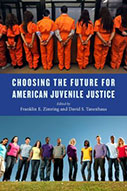Choosing the Future for American Juvenile Justice

Edited by Franklin E. Zimring and David Tanenhaus
Publisher: New York: New York University Press, 2014, 256p.
Reviewer: Barry Krisberg | November 2014
The world of juvenile justice has never been in more flux since the landmark case In re Gault 387 U.S. 1 (1967) introduced basic due process standards to the informal juvenile court system. In the past few years, the basic jurisprudence of serious and violent youthful offenders has been profoundly altered. The U.S Supreme Court ended capital punishment for persons who committed their crimes before the age of 18, restricted the sentence of Life Without Parole for minors and severely curtailed very long sentences ( the virtual life sentence) for juvenile offenders.
Juvenile arrests have declined steadily since the mid-1990s, and the number of youngsters in juvenile correctional facilities has dropped by almost half. There are renewed calls for raising the age at which juveniles can be tried in criminal courts, after nearly two decades of federal and state laws that encouraged handling youthful offenders in the adult prisons.
There are new examinations of how public schools deal with crimes that occur on their campuses and new interest in ideas such as restorative justice as an alternative to the traditional punishment mode. There has been an increase in civil rights litigation on behalf of incarcerated young people. Issues of the over-representation of minority youth in the juvenile justice system are getting focused attention at the federal and state level. There is a new interest in how young women are being processed by the juvenile court system.
Into this dynamic policy environment come Professors Zimring and Tanenhaus and their colleagues who speculate on where the future of juvenile justice is heading. This collection of short essays is prologue to a book series by NYU Press that will engage many key topics in greater detail. The list of authors is impressive, and represents some of the most incisive thinking on juvenile justice.
The views in the book are not “conventional” and the authors challenge some of the oft-repeated statements about adolescent neuropsychology, the “school to prison pipeline”, juvenile sex offenders, and the confidentiality of juvenile court records. This is a book for instructors who want to help their students to become “critical thinkers,” and to stretch thinking beyond the standard clichés.
Within a moral context that values every young person and demands that our children be protected and also receive fairness from the justice process, Zimring and Tanenhaus ask us to dream about a better future.
There are no easy policy and programmatic answers provided in Choosing the Future for American Juvenile Justice. This edited volume challenges the reader to think creatively and to continue the rich evolution of the juvenile court. The current period of rapid change in the juvenile justice system reminds us of the vast changes that occur in adolescence and the need to be mindful about the prospects for positive social change.
Barry Krisberg is a Senior Fellow, UC Berkeley Law School


